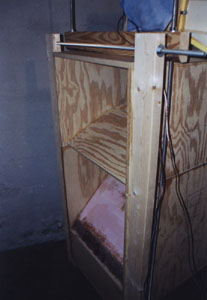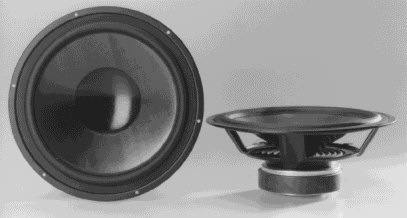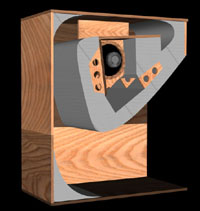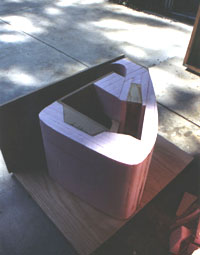
Hornloaded Subwoofer


|
In designing this horn, I was primarly constrained by my budget. This is what led me to base the design around my pair of Peerless 850146 drivers (10" drivers). These drivers are not normally what would be considered horn drivers. They have an efficiency bandwidth product (EBP) of only 56.7 while conventional wisdom would say that a horn driver break 200 on this figure. Lucky for me this 'rule' is typically misapplied - the missing factor is the frequency range the horn is being designed to cover. These drivers have a poly cone and a moderate excursion (9mm). This actually used to be considered a large excursion, believe it or not. The poly cone is probably not a very good feature for a bass horn driver, but it will have to do for now. For a bass horn (and any other subwoofer, for that matter), the more linear volume displacment the drivers have, the better. Plugging the drivers' Thiel-Small parameters into my design spreadsheet (based on Leach's horn model detailed in AES preprint #1405 and elsewhere), I saw that I could achieve fairly high efficiency (~108dB/watt predicted) with these drivers by designing for a very narrow bandwidth - 26.7hz to 100hz. This prediction was supported by simulation using David McBean's Horn Response program. |
|||||||||||||||||||||||||||||||||||||||||||||||||||||||||||||||||||||||||||||||||||||||||||||||||||
|
My other design constraint was that the subwoofer had to be small enough to get up my stairs, around the corners, and fit in my closet. My original plan was to slide the sub into the closet that's in the corner of my room so I would have true corner loading while avoiding the situation of having the speaker pointed into the corner. To meet this goal, I was constrained in both width, height, and depth. At the same time I needed enough area on the side of the box for the horn's mouth. Resolving all this led me to design the box to break apart into two sections. This would allow it to be taller to get the needed mouth area, and the pieces would fit around corners individually when stood on end.
|

|
|||||||||||||||||||||||||||||||||||||||||||||||||||||||||||||||||||||||||||||||||||||||||||||||||||
|
The horn's folding scheme is based on the Servodrive BT-7. It looks like a nautilus shell - the driver is in the middle of the box, and the horn wraps around it. This is a fairly efficient folding pattern and has the additional benefit of only requiring one 180 degree bend - the other two bends are only 90 degrees. While this was not the exact sequence of how I worked through the design of the horn, the above thoughts should give an idea of why I did what I did in this project. The rendering above right is from the design phase of the project - it's an AutoCAD solid model that I made to visualize the box. The picture on the right is the top portion of the box before attaching the second side panel - it corresponds almost exactly to the rendering above (as it should!). The overall size of the box is 22.5 inches wide, 44.5 inches long, and 51.5 inches tall. The 2x4's that I use to clamp the two pieces of the box together make it a little wider and taller. The mouth area is 840 square inches. For a 26.7hz low cutoff loaded into 1/8 space, the mouth area predicted by standard theory is 2557 square inches, so I would really need three of these subwoofers to get the mouth area big enough to make the horn act like it was infinitely large. This is probably what accounts for the drooping low frequency response, which can be seen below. It also probably accounts for some of the lumpiness in the frequency response. However, the horn is slightly longer than 1/4 of the wavelength of 26.7hz, and I would guess that this is why it performs as well as it does. |

|
|||||||||||||||||||||||||||||||||||||||||||||||||||||||||||||||||||||||||||||||||||||||||||||||||||
Copyright 1999-2004, John H Sheerin
Click here to return to my home page.